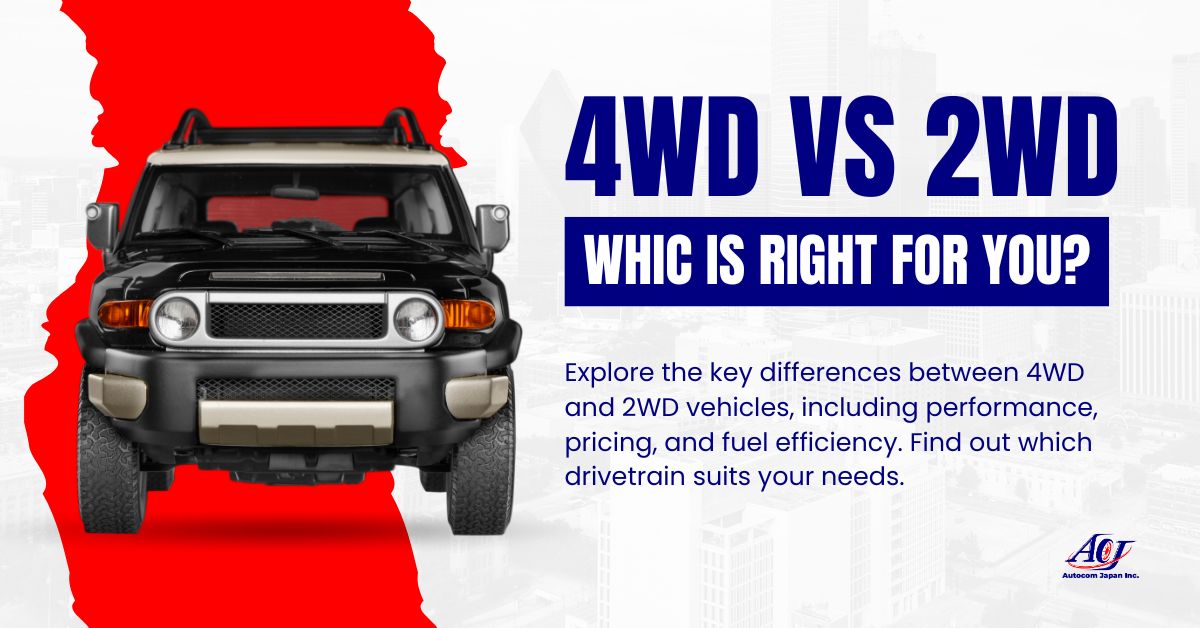
When it comes to choosing between a 4-wheel drive (4WD) and a 2-wheel drive (2WD) vehicle, understanding the key differences is essential. Your decision will directly impact how the vehicle performs, especially under tough road conditions. In this article, we’ll compare both drivetrains, examining their strengths, performance, and affordability to help you make an informed choice.
What is 4-Wheel Drive (4WD)?
4WD is a drivetrain system designed to send power to all four wheels simultaneously. This system is commonly found in off-road vehicles, pickup trucks, and SUVs provided by companies like Autocom Japan. 4WD enhances traction and control on difficult terrains such as snow, mud, and steep inclines. When engaged, the system distributes power evenly across all wheels, offering improved stability and handling in adverse conditions.
What is 2-Wheel Drive (2WD)?
2WD refers to a drivetrain system where power is transmitted to only two wheels, typically either the front (FWD) or the rear (RWD) wheels. This system is common in sedans, compact cars, and small SUVs. While lacking the off-road capabilities of 4WD, 2WD vehicles are generally more fuel-efficient, cost-effective, and easier to maintain.
Features and Benefits
4-Wheel Drive (4WD)
- Off-Road Performance: 4WD systems are specifically designed for rugged terrains and inclement weather, offering superior traction and power for uneven surfaces.
- Enhanced Stability: With power distributed to all four wheels, 4WD vehicles maintain better control on slippery roads, reducing the risk of skidding.
- Towing Capabilities: Typically, 4WD vehicles are built for heavy-duty tasks, making them a go-to for towing and hauling.
- Resale Value: 4WD cars often hold their value longer, appealing to buyers in the used market, particularly those seeking rugged durability.
2-Wheel Drive (2WD)
- Fuel Efficiency: With only two wheels requiring power, 2WD vehicles are generally more fuel-efficient, translating into savings over time.
- Affordability: 2WD vehicles usually come with a lower price tag, making them a practical option for budget-conscious buyers.
- Improved Handling: Thanks to their simpler design and lighter weight, 2WD cars typically offer smoother handling and maneuverability, especially in city driving.
- Lower Maintenance Costs: Fewer moving parts and a simpler drivetrain mean fewer components are at risk of failure, leading to reduced maintenance expenses.
Performance Comparison
Off-Road Capabilities
4WD vehicles shine in off-road and difficult driving environments, effortlessly handling steep hills, loose gravel, and harsh weather conditions. In contrast, 2WD vehicles are best suited for smoother surfaces, where agility and control are prioritized over raw traction.
Fuel Efficiency
The edge goes to 2WD in terms of fuel economy. By sending power to just two wheels, the engine doesn’t need to work as hard, leading to better mileage. Modern advancements have improved the efficiency of some 4WD systems, but they generally still lag behind 2WD counterparts in this area.
Handling and Maneuverability
Due to their lighter build, 2WD vehicles excel in city driving and tight urban spaces. Their reduced weight and simplified suspension contribute to better handling. On the other hand, 4WD cars, though powerful in off-road scenarios, can feel less nimble in everyday driving conditions.
Pricing and Affordability
2WD vehicles are typically more affordable to purchase and maintain. Their simplified systems result in lower upfront costs and reduced long-term maintenance needs. In contrast, 4WD cars, while more expensive, provide better versatility for those who regularly face challenging terrain or need to tow heavy loads.
Making the Right Choice
Choosing between 4WD and 2WD ultimately depends on your driving habits and environment. If you frequently navigate difficult terrains or tow heavy loads, a 4WD vehicle is likely a better fit. However, if your driving consists mainly of urban commutes, a 2WD car offers greater fuel efficiency, easier handling, and lower overall costs.
Conclusion
Both 4WD and 2WD vehicles have their advantages. For drivers facing tough terrains or rough weather, 4WD offers peace of mind with its extra stability and capability. However, for those prioritizing cost, fuel efficiency, and ease of handling, a 2WD may be the smarter, more economical choice.
Whether you’re in the market for a capable off-roader or a cost-efficient commuter, understanding the strengths and limitations of each drivetrain will help you make a well-informed decision that matches your needs.

